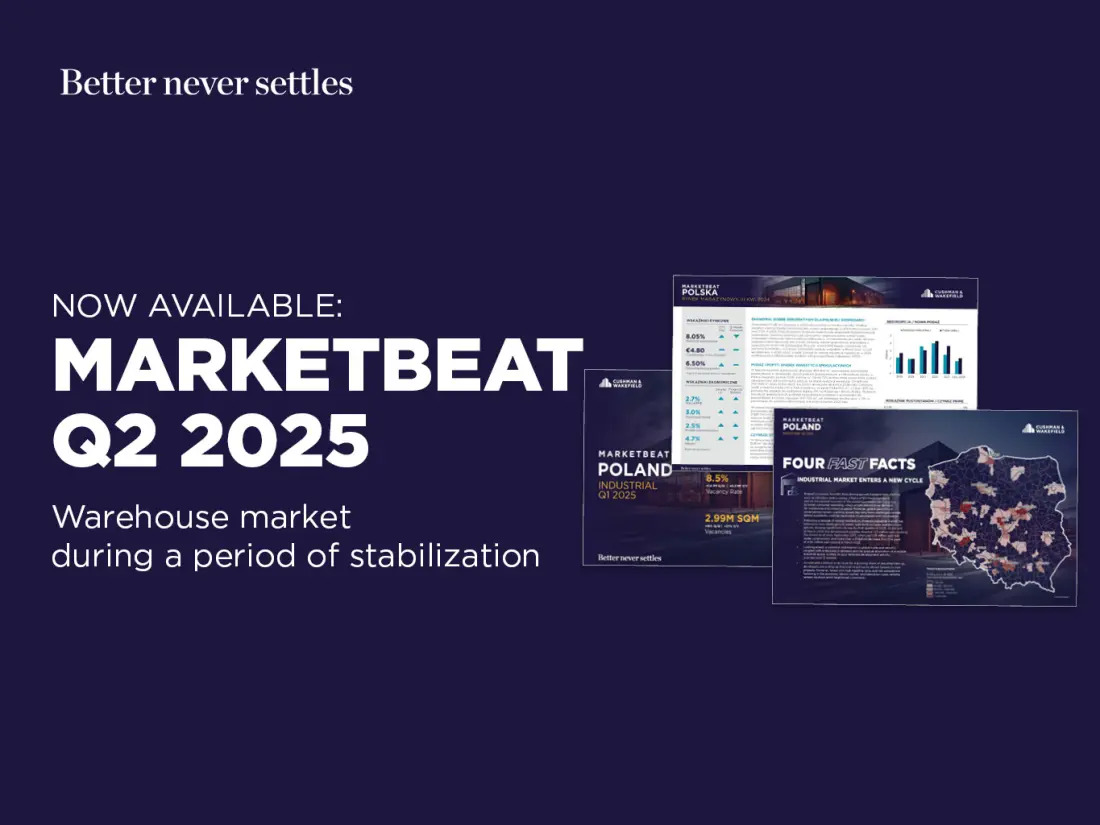Industrial Market Enters Stabilisation Phase
18 august 2025

Contents
TAKE-UP: Leasing activity dominated by renegotiations
“The first half of 2025 saw nearly 3 million sqm of industrial space transacted, representing a 10% year-on-year increase and exceeding the first-half average for 2020-2024 by more than 4%,” comments Anita Mikusek, Senior Research Consultant, Cushman & Wakefield.
Take-up continued to be dominated by renegotiations, which accounted for 54% of total leasing activity. Although their share declined slightly over the quarter, from 56% in Q1 to 53% in Q2, this trend aligns with the increase in renewals from around 30% to 40% between 2023 and 2024.
“While we are seeing a high number of enquiries about industrial space, the take-up structure – dominated by renegotiations – suggests that many enquiries are still made for benchmarking purposes, with a view to optimising leasing conditions in existing locations. As a result, it remains uncertain whether this uptick in activity will translate into a genuine increase in net take-up or new developments. Meanwhile, the growing importance of nearshoring and infrastructure projects provides a solid foundation for expectations of a rebound in the second half of the year. Although the PMI, which provides a snapshot of the health of the manufacturing sector, fell from 47.1 in May to 44.8 in June – signalling a deterioration of economic conditions and a temporary slowdown in the sector – ongoing and planned investments in energy and digital infrastructure are expected to drive additional demand for warehouse and industrial space,” adds Anita Mikusek, Senior Research Consultant, Cushman & Wakefield.
New leases and expansions surpassed 1.3 million sqm, with more than 860,000 sqm transacted in the second quarter of 2025.
SUPPLY: Moderate rebound in construction activity
“Approximately 470,000 sqm of new industrial space was completed during the second quarter of 2025, bringing Poland’s total stock to over 36 million sqm. The Polish market has more than doubled over the past six years, reflecting the impressive growth of the logistics sector in Poland. If all industrial and logistics buildings were placed side by side, they would cover an area equivalent to 7% of Warsaw, 11% of Krakow or 12% of Wrocław,” explains Anita Mikusek, Cushman & Wakefield.
The top three provinces in terms of stock are Mazovia (approx. 7.2 million sqm), Silesia (6.1 million sqm) and Lower Silesia (5.3 million sqm).
“In the second quarter of 2025, construction work began on nearly 660,000 sqm of industrial space – more than double the amount in the first quarter, bringing Poland’s total development pipeline to approximately 1.5 million sqm at the end of the first half of 2025. While this indicates a slight rebound relative to the first quarter, it is 26% lower year-on-year, confirming the ongoing downward trend in development activity. The share of speculative construction remained at 41%, equivalent to 603,000 sqm available for lease, reflecting developers’ moderate optimism about future occupier demand,” adds Anita Mikusek, Cushman & Wakefield.
Mazovia continues to lead the way for development activity, accounting for 32% of Poland’s total stock under construction. Strong momentum is also seen in Silesia (14%), while Łódzkie and Pomerania were neck and neck in the second quarter in terms of their share of the development pipeline at 12% each, equating to approximately 172,000 sqm of industrial space under way in each of the two regions.
In the current market environment, new project starts are increasingly contingent on securing tenants in advance – either by increasing occupancy in existing facilities or arranging pre-leases. Purely speculative construction remains constrained and is largely concentrated on selected core submarkets with low vacancy rates.
VACANCIES: New supply absorbed, but unevenly
In the second quarter of 2025, warehouse and industrial availability across Poland contracted to 2.95 million sqm, bringing the overall vacancy rate down to 8.2% – a decline of 0.3 percentage points quarter-on-quarter and 0.16 percentage points year-on-year.
The highest vacancy rates were recorded in Lubuskie (18.4%), Świętokrzyskie (17.2%) and Pomerania (10.7%). At the other end of the spectrum, supply-constrained regions such as Podlaskie and Warmia-Masuria reported zero vacancies, while Opolskie stood at 1.7%.
Looking ahead, the current slowdown in speculative construction is expected to keep vacancy rates in check, helping to stabilise the market and support a balanced dynamic in the coming quarters.
RENTS: Market holds steady, but pressures linger
Rental rates remained largely unchanged during the second quarter of 2025, though some locations saw slight downward adjustments. Headline rents stood at EUR 3.60-5.75 per sqm for big-box warehouses and EUR 4.00-8.25 per sqm for SBU/City Logistics projects.
“The outlook for the coming months points to continued stability in both rental rates and leasing activity. The market holds steady, with pressure on price adjustments limited to locations with elevated vacancy levels,” concludes Anita Mikusek, Cushman & Wakefield.
LABOUR MARKET: H1 2025 in the blue-collar sector
According to data from Ranstad Polska, in the second quarter of 2025, the highest base labour rates for blue-collar workers (both skilled and non-skilled)1 were recorded in Świętokrzyskie and Lesser Poland at nearly PLN 40 per hour. Hourly rates in Lower Silesia, previously the costliest region, stood at over PLN 37.
By contrast, the lowest labour rates for production workers were in Warmia-Masuria, at just over PLN 31 per hour. The average gross base rate for all the provinces amounted to PLN 36.19 per hour.
“Wage disparities across regions are driven, among other factors, by the level and pace of regional growth and population density. Notably, registered employee turnover remains stable. However, this stability is not a result of overall satisfaction with employment conditions, as might be expected, but rather reflects a limited number of job opportunities and the conditions offered by employers. According to Q1 data, the average job search duration reached a record high of 3.3 months,” comments Dagmara Żuromska, National Sales and Key Account Manager, Randstad Polska.

